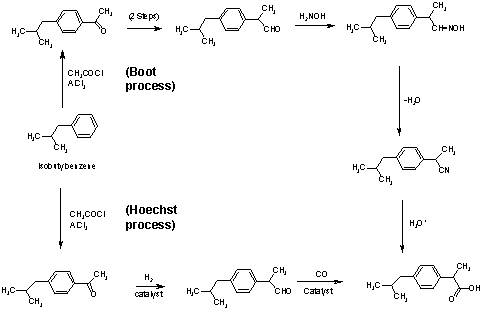
Synthesis
Two synthetic routes to ibuprofen:-

(This image was copied from www.chem.vt.edu without permission)
There have been many commercial and laboratory publications for the synthesis of Ibuprofen. Two of the most popular ways to obtain Ibuprofen are the Boot process and the Hoechst process. The Boot process is an older commercial process developed by the Boot Pure Drug Company, and the Hoechst process is a newer process developed by the Hoechst Company. Most of these routes to Ibuprofen begin with isobutylbenzene and use Friedel-Crafts acylation. The Boot process requires six steps, while the Hoechst process, with the assistance of catalysts, is completed in only three steps.
Cheminor Drugs have developed a process for an improved version of ibuprofen based on chiral synthesis. The move is significant given that pure S-Ibuprofen (the active form of ibuprofen) could near halve the regular ibuprofen dosage, besides improving the side-effect profile.
However the human body can convert the inactive (R) form into the (S) form, so eventually 100% of the ibuprofen taken becomes active. The process discovered by Cheminor is therefore unlikely to have commercial significance.